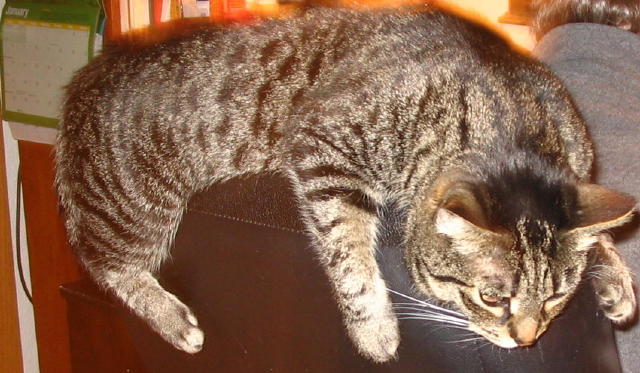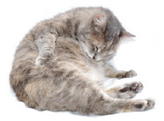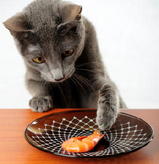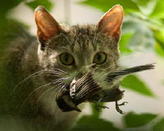Cat Ringworm

Coty, relaxing on the back of the chair
Cat ringworm is a nasty fungus but its not life threatening although it threatens your cat's skin health. It is not actually a worm at all. The name was coined years ago because it often causes round sores, surrounded by small blisters that look like worms. It often isn't visible until you start investigating after you find a nasty red circular mark on yourself....yes, a human can get it.
Ringworm is a “zoonosis” which means that it is an animal disease that can be transmitted to humans. However, because humans don’t have fur covering affected areas it is easier to treat. When kittens have it, you usually see the classical circular, scaly lesions; but in older cats, the signs are variable. It isn't life threatening to either the cat or yourself but it is highly contagious. If you have any suspicions have your cat checked out right away.
There are a number of skin disorders in a cat that can cause the same clinical symptoms as ringworm so there are specific diagnostic procedures to obtain a definitive diagnosis. As a first step your vet may use an ultraviolet light called a “Woods light”. Under this light, hairs with ringworm glow a bright green fluorescence.
The Woods light on its own cannot establish a diagnosis, because not all strains of ringworm fluoresce, plus there are medications and other substances that do fluoresce but the light helps a vet choose which hairs to test further.
The hairs are examined under a microscope, and then placed on a culture plate to test for any growth of ringworm organisms. Skin scrapings and scale samples are also cultured. The fungal culture in the cat usually grows positive within two to four weeks.
If growth occurs, the spores are taken off the plates, stained, and examined under a microscope to determine which ringworm organism is involved. A culture that is positive for ringworm is significant, and warrants treating the cat. This will facilitate an earlier recovery for your cat and reduce the chance of transmission to humans and other animals.
Cat ringworm is caused by a family of fungi that are known as dermatophytes, which translates to “skin loving” and this type of fungal infection is dematophytosis. These fungi thrive on an animals’ skin. They are not strictly species-specific, but certain strains tend to live on certain hosts. The type of ringworm fungus that 95% of the time infects cats is called Microsporum canis.
The same organism also causes most cases of ringworm in dogs. Occasionally, however, fungi Microsporum gypseum or Trichophyton mentagrophytes are involved. Most commonly, cats contract the M. canis disease from another animal that has ringworm.
When fungal organisms invade and grow in the skin, hair, and nails, they produce microscopic spores. These spores can contaminate the environment, or be passed directly to another individual by contact. A feline with cat ringworm is continuously shedding spore-laden hairs.
One factor that can predispose a cat to developing cat ringworm is age. The immune system of a kitten is not as mature as that of an adult cat, hence kittens are more susceptible to infection. A kitten nursing from a ringworm-infected mother will usually develop ringworm. Skin parasites such as mites and fleas, can irritate the skin and allow it to be more susceptible to fungal invasion.
Exposure to ringworm does not always cause infection. An asymptomatic cat showing no lesions can harbor the organism on its hair-coat, remaining healthy but spreading the disease to others.
The skin has a natural defense system against cat ringworm because the oil glands in the skin produce substances that make it less hospitable to fungi. Sebum, for example, is an oily substance that spreads out onto the skin and hair and acts as a chemical barrier to prevent fungi organisms from invading.
The skin’s normal defenses, along with the usual feline fussy grooming techniques, help to prevent spores from invading the outer layers of the skin, hair and nails. When this defense fails… cat ringworm occurs. If left untreated, infections are usually self-limiting and will eventually resolve on their own but this can take months or even years.
There are numerous treatments for feline ringworm which include pills, salves, ointments, shampoos and bathing dips. In time the cat’s immune system will kill off the fungi but the treatment regimen is usually determined by a veterinarian on a case-by-case basis.
Once confirmed vets usually prescribe both a topical anti-fungal ointment and an oral anti-fungal drug. Oral treatment drugs such as Griseofulvin, which is approved by the FDA for use in dogs and cats, can cause some cats to react with diarrhea or vomiting etc. so the vet will monitor a cat closely. Prior to drug therapy your vet will do a complete blood count and test for FIV and FeLv because some drugs cannot be given to cats suffering from those viruses.
It is not unusual for drug treatments to take over a month before all spores are gone. Bathing the cat with an anti-fungal shampoo, followed by dipping in lime sulfur solution, is a common topical treatment. The dip solution is left on the body to dry.
The cat should be kept warm until completely dry to prevent hyperthermia. An Elizabethan collar will protect your cat from licking an excess amount off of his coat and although lime sulfur is reported to be safe even in kittens, it is, however, stinky and can be irritating if ingested in large quantities. Too much licking can cause mouth ulcers and gastrointestinal upsets. If your cat is light colored, her coat will be temporarily stained.
It is important to take some precautions when bathing and dipping a cat. Wear protective eyewear and rubber gloves. Remove all jewelry because the lime solution can cause tarnishing and discoloration. There are also other topical products available. There is also a vaccine for cat ringworm designed to boost the immune system response of infected adult cats. However, vaccination does not prevent it, but it can help defeat a pre-existing infection.
Unfortunately curing your infected cat is only half of the battle. The spores can live in the environment for well over a year so you must clean everything completely even air ducts. Your vet can recommend a safe disinfectant to use on bedding, litter pans, scratching posts, grooming tools, rugs, and any other items your infected cat comes in contact with on a regular basis. A 1:10 dilution of bleach to water can be used on all non-porous surfaces. Consultation with your vet is recommended.
Related Articles......
Return from Cat Ringworm to Cat Health Homepage
Having trouble finding what you need? Cat Health Index & Site Map
OR
Do you have a question to ask?...Questions
OR
Do you have a cat story to share?...Simply click here to go to that page!
Copyright@2010-2020 All rights reserved.Cat-health-detective.com
This website is information only. Consult a veterinarian for medical assistance

"Like Us" on Facebook
or...
"Like Us" here




















